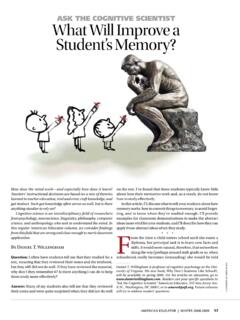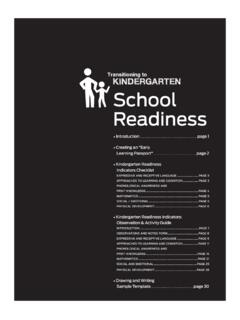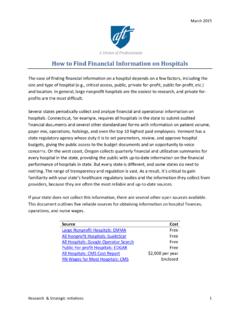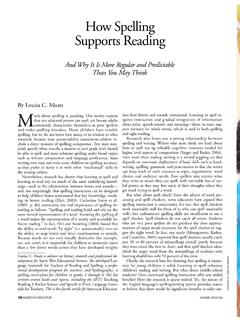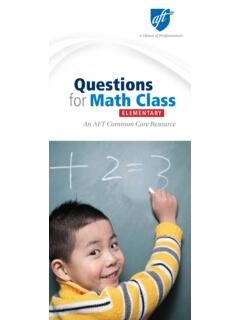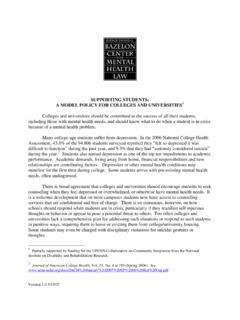Transcription of Supporting Students Autism - AFT
1 Supporting Students with Autism 1 Supporting Students with AutismRandi WeingartenpresidentLorretta Johnsonsecretary-treasurerMary Cathryn Rickerexecutive vice presidentAFT Executive CouncilOur Mission The American Federation of Teachers is a union of professionals that champions fairness; democracy; economic opportunity; and high-quality public education, healthcare and public services for our Students , their families and our communities. We are committed to advancing these principles through community engagement, organizing, collective bargaining and political activism, and especially through the work our members American Federation of Teachers, AFL-CIO (AFT 2017). Permission is hereby granted to AFT state and local affiliates to reproduce and distribute copies of the work for nonprofit educational purposes, provided that copies are distributed at or below cost, and that the author, source, and copyright notice are included on each copy.
2 Any distribution of such materials to third parties who are outside of the AFT or its affiliates is prohibited without first receiving the express written permission of the Y. AbramsMary J. ArmstrongBarbara BowenChristine CampbellZeph CapoAlex Caputo-PearlDonald CarlistoLarry J. Carter A. ChavezMelissa CropperEvelyn DeJesusMarietta A. EnglishEric FeaverFrancis J. FlynnDavid GrayDavid HeckerJan HochadelFedrick C. IngramJerry T. JordanTed KirschFrederick E. KowalKaren GJ LewisKaren E. MageeLouis MalfaroJoanne M. McCallJohn McDonaldMartin MessnerDaniel J. MontgomeryMichael MulgrewRuby J. NewboldCandice OwleyAndrew PallottaJoshua PechthaltPaul PecoraleDavid J. QuolkeStephen RooneyDenise SpechtWayne SpenceTim StoelbAnn TwomeyAdam UrbanskiSupporting Students with Autism4 AFT Supporting Students with Autism EContents 1 Introduction 1 Autism Spectrum Disorder Diagnosis the Diagnostic and Statistical Manual 1 Special Education Eligibility Autism 2 Effective Education for Students with Autism 2 Evidence-Based Practices 2 Social Skills/Social and Emotional Learning 3 Addressing Challenging Behavior 4 Collaborating with Paraprofessionals 6 Teens and Young Adults with Autism 9 Working with Families 10 Building a Relationship with Parents and Families 11 Life Beyond School 12 Resources 12 Recommended Reading 13 Additional ResourcesF AFT Supporting Students with Autism Department of Education 2015-16 school year data indicate that there are more than 620.
3 000 children ages 3-21 attending school under the educational eligibili-ty classification of Autism .* Data from the Centers for Disease Control and Prevention indicate that as many as one in 68 children has an Autism spectrum disorder (ASD). Autism is one of the educational eligibility cat-egories for special education. Individualized educa-tional program (IEP) teams can deem children eligible for special education services under the category of Autism . This prevalence rate has been increasing over the years, and the current rate implies most educators will be responsible for Supporting the needs of stu-dents with ASD at some point during their career. With improved understanding of the unique characteristics of individuals with ASD, educators can improve the ed-ucational experience and academic success of Students with Autism . Department of Education. 2017: programs/osepidea/618-data/static- Autism Spectrum Disorder Diagnosis the Diagnostic and Statistical ManualThe Diagnostic and Statistical Manual of Mental Disor-ders (DSM), published by the American Psychological Association, provides a common language and stan-dard criteria for the classification of mental disorders.
4 The most recent edition, the DSM-5, was published in 2013. In this edition, the diagnostic criteria for Autism Spectrum Disorder (ASD) was established. To receive the diagnosis of ASD, individuals must exhibit per-sistent deficits in social communication and social interactions and restricted, repetitive patterns of behav-ior, interests or activities. Prior to 2013, additional diag-nostic categories existed including: Autistic Disorder, Asperger s Disorder, Childhood Disintegrative Disor-der, Pervasive Developmental Disorder-Not Otherwise Specified, and Rett s Disorder. If individuals received their diagnosis prior to 2013, these diagnoses may have been provided. Individuals with ASD can present with a wide range of abilities. Some individuals with ASD will need substantial support throughout their lives to meet daily needs, while others will not. Special Education Eligibility AutismThe Individuals with Disabilities Education Act (IDEA) has categories of disabilities that allow children to qualify for special education services and supports.
5 Autism is one of the educational eligibility categories for special education. Individualized educational pro-gram (IEP) teams can deem children eligible for special education services under the category of Autism . Eligibility for special education is not based solely on the evidence of a disability ( , ASD) but also requires that a student needs special services to benefit from education. 2 AFTE ffective Education for Students with AutismEvidence-Based PracticesEducators have an obligation to deliver effective inter-vention to Students with Autism . There has been signif-icant research establishing what interventions, when delivered with fidelity, promote the best opportunity for optimal outcomes. The interventions that researchers have shown to be effective are called evidence-based practices, or EBPs. The National Professional Devel-opment Center on Autism Spectrum Disorder (NPDC) was funded by the Department of Education s Office of Special Education Programs to determine and promote the use of evidence-based practices for children and youth.
6 The NPDC has developed free professional development and implementation resources for the dozens of evidence-based practices for education stu-dents with Autism . To appropriately meet the needs of Students , teachers and administrators must be knowl-edgeable about evidence-based approaches. Social Skills/Social and Emotional LearningIt is reasonable to assume that many Students with Autism will have goals and objectives in their educa-tional program to address social skills. With effective intervention, Students with Autism can increase their success in social and emotional learning. Social and emotional learning for all Students is gaining increased focus in today s schools, with the understanding that When working with Students with Autism , an effective educational program will capitalize on the individual student s interests, offer a predictable schedule, teach tasks as a series of simple steps, actively engage the student s attention in highly structured activities, and provide regular reinforcement of behavior.
7 Supporting Students with Autism 3all Students can benefit from an increased emphasis on instruction in these areas. Direct instruction in social skills development should be done in the same way that other educational needs are addressed. Students with Autism require specific instruction to improve their social skills development. Specific curriculums to teach social skills have been developed ( , Skillstreaming). These curriculums can be a great starting point for instruction in social skills. Students with Autism also need opportunities to learn and practice social skills in a natural environ-ment. Generalization of social skills from a structured learning setting must be practiced and performed in a natural setting. Students with Autism do want to develop relationships with their peers. Educating both the student with au-tism and their typical peers is necessary. When typical Students receive accurate and straightforward infor-mation about Autism and, more important, when they receive information about specific strategies to use, they can interact more frequently and more effectively (Kamps, Thiemann-Borque, Heitzman-Powell, et al.)
8 , 2015). Addressing Challenging BehaviorTwo of the core challenges for Students with Autism are communication and socialization. These communica-tion and social deficits, at times, can result in Students with Autism responding to situations inappropriately. Behaviors exhibited by Students with Autism may in-clude loud vocalizations, leaving the instructional area, self-injury, aggression or other inappropriate behav-iors. The important thing to note is that this behavior is exhibited because of communication and social deficits. With a high-quality, systematically imple-mented positive behavior support plan, Students with Autism even those with the most challenging behav-ior can achieve a reduction in inappropriate behavior and success in an educational environment. To effectively address challenging behavior, the educational team must understand why a behavior is occurring. A functional behavior assessment can be completed to assist in determining why a behavior is occurring.
9 The assessment should include: Clear description of the problem behavior(s); Activities, times and situations that predict when behaviors will and will not occur ( , setting events); Consequences that maintain the problem behaviors ( , functions); Summary statements or hypotheses; and Direct observation data to support the hypotheses. 4 AFTUpon completion of a functional behavior assessment, a positive behavior support plan can be developed and should include: Modifications in the environment that reduce the likelihood of the problem behavior; Teaching plans for developing adaptive behaviors and replacement skills; Natural and minimally intrusive consequences to promote positive behavior and deter problem behaviors; and A crisis plan (if needed). Specific training, including coaching and modeling of the implementation of the positive behavior support plan, should be provided to all team members respon-sible for implementing the plan.
10 A high-quality, well-implemented behavior support plan can be highly effective in promoting positive behavioral with ParaprofessionalsThe primary role of a paraprofessional is to assist the teacher in providing a meaningful education for a child with Autism . A paraprofessional can assist the student in achieving their educational goals through direct instruction and indirect support in the classroom. A paraprofessional can help mediate communication, socialization and behavioral challenges and encourage the student to have success in the educational environ-ment. It is important to highlight that paraprofessionals should be working in concert with the education-al team. Clear roles should be defined for all team members. Clear instructional plans and schedules developed by the educator/other professionals and the paraprofessional should outline expectations for all team members.
